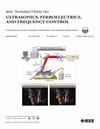Tissue Clutter Filtering Methods in Ultrasound Localization Microscopy Based on Complex-Valued Networks and Knowledge Distillation
IF 3.7
2区 工程技术
Q1 ACOUSTICS
IEEE transactions on ultrasonics, ferroelectrics, and frequency control
Pub Date : 2025-02-24
DOI:10.1109/TUFFC.2025.3544692
引用次数: 0
Abstract
Ultrasound localization microscopy (ULM) is a blood flow imaging technique that utilizes micrometer-sized microbubbles (MBs) as contrast agents to achieve high-resolution microvessel reconstruction through precise localization and tracking of MBs. The accuracy of MB localization is critical for producing high-quality images, which makes tissue clutter filtering an essential step in ULM. Recent advances in deep learning have led to innovative methods for tissue clutter filtering, particularly those based on 3-D convolution, which effectively capture the spatiotemporal features of MBs. These methods significantly improve upon traditional approaches by addressing issues such as lengthy inference time and limited flexibility. However, many deep learning techniques primarily focus on B-mode images and demonstrate lower efficiency. To overcome these limitations, this study proposes knowledge distillation for tissue clutter filtering to enhance filtering efficiency while maintaining performance. This study first develops a lightweight 2-D complex-valued convolutional neural network (CCNN) (CL-UNet) as the teacher model, utilizing I/Q signal input. Subsequently, a 2-D real-valued convolutional neural network (CNN) (UNet-T) is developed as the student model, which uses envelope data as input. Feature-based knowledge distillation is applied to transfer knowledge from the teacher model to the student model (Guided UNet-T). All models are trained on simulated data and fine-tuned on in vivo data. The experimental results show that CL-UNet (I/Q, ours) demonstrates better filtering performance compared to the B-mode image-based approach on both simulated and in vivo data. Guided UNet-T outperforms both singular value decomposition (SVD) and random SVD (RSVD) in terms of both performance and speed, offering the best balance between filtering efficiency and effectiveness.基于复值网络和知识蒸馏的超声定位显微镜组织杂波滤波方法。
超声定位显微镜(ULM)是一种利用微米级微泡(mb)作为造影剂,通过精确定位和跟踪mb实现高分辨率微血管重建的血流成像技术。MB定位的准确性是产生高质量图像的关键,这使得组织杂波滤波成为ULM中必不可少的步骤。深度学习的最新进展导致了组织杂波滤波的创新方法,特别是基于3D卷积的方法,可以有效地捕获mb的时空特征。这些方法通过解决诸如冗长的推理时间和有限的灵活性等问题,大大改进了传统方法。然而,许多深度学习技术主要集中在b模式图像上,效率较低。为了克服这些局限性,本研究提出了组织杂波滤波的知识精馏,在保持性能的同时提高了滤波效率。本研究首先利用I/Q信号输入,开发了一个轻量级2D复值CNN (CL-UNet)作为教师模型。随后,以包络数据作为输入,建立二维实值CNN (UNet-T)作为学生模型。采用基于特征的知识蒸馏将知识从教师模型转移到学生模型(Guided UNet-T)。所有模型都是在模拟数据上进行训练,并在体内数据上进行微调。实验结果表明,与基于b模式图像的方法相比,CL-UNet (I/Q, our)在模拟和体内数据上都表现出更好的滤波性能。引导UNet-T在性能和速度上都优于奇异值分解(SVD)和随机奇异值分解(RSVD),在过滤效率和有效性之间提供了最佳的平衡。
本文章由计算机程序翻译,如有差异,请以英文原文为准。
求助全文
约1分钟内获得全文
求助全文
来源期刊
CiteScore
7.70
自引率
16.70%
发文量
583
审稿时长
4.5 months
期刊介绍:
IEEE Transactions on Ultrasonics, Ferroelectrics and Frequency Control includes the theory, technology, materials, and applications relating to: (1) the generation, transmission, and detection of ultrasonic waves and related phenomena; (2) medical ultrasound, including hyperthermia, bioeffects, tissue characterization and imaging; (3) ferroelectric, piezoelectric, and piezomagnetic materials, including crystals, polycrystalline solids, films, polymers, and composites; (4) frequency control, timing and time distribution, including crystal oscillators and other means of classical frequency control, and atomic, molecular and laser frequency control standards. Areas of interest range from fundamental studies to the design and/or applications of devices and systems.

 求助内容:
求助内容: 应助结果提醒方式:
应助结果提醒方式:


